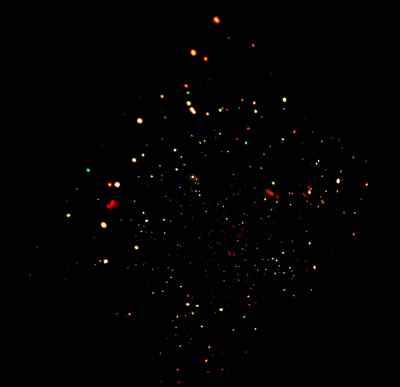This is what the measurements of the Chandra space telescope in the X field show

Active X-ray sources as imaged by the Chandra Space Observatory
Data from space observatories in the field of X-rays reveals that black holes are more common in the universe than previously thought and they also evolved at a different length than researchers expected. This is what an astronomer from the University of Pennsylvania claims.
"We wanted to conduct a census of all known black holes and we wanted to know how they behave," said Neil Brandt, professor of astronomy and astrophysics. "We also wanted to measure how big black holes have grown over the history of the universe."
Brandt and the other researchers did this by viewing a section of the sky in the northern hemisphere with the Chandra Space Telescope's north-facing X-ray camera and a similar section in the southern hemisphere with another south-facing Chandra camera. Both cameras have a deep field.
The studies were also carried out in other parts of the sky, both by Chandra and by the European Space Agency's Newton spacecraft.
The researchers examined the emissions of these bodies in the X-ray region because black holes emit a lot of radiation in this region. The penetrating nature of X-rays provides a direct way to detect black holes. By using X-rays, astronomers can pinpoint black holes at the centers of galaxies without their signal being washed out by the visible light coming from the stars in that galaxy. Brand reported the findings at the annual meeting of the American Association for the Advancement of Science in St. Louis. The black holes they studied were the ones that are in the center of galaxies and are active in the X field, therefore they are called active galactic nuclei."
"We found supermassive black holes at the centers of massive galaxies." said Bernadette. "Our galaxy also has a black hole at its center which is estimated to be about 2.6 million solar masses. 'Our' black hole is not currently active, but we estimate that it was active in the past.
The pieces of sky scanned were carefully selected because they are free of anything that might interfere with the absorption of the X-rays. The northern segment is an area of the sky about two-thirds the size of the full moon. Chantadra scanned it for 23 days over a period of two years. The researchers located about 600 X-ray sources. After comparing the X-ray images with optical images of the same regions in the sky using the Hubble Space Telescope, it turns out that almost all of these 600 are in galaxies that have a presence in the visible range and are therefore likely detectors of optical galaxies.
"X-ray astronomers are 10 times better able to detect galactic nuclei than astronomers observing other areas of the electromagnetic spectrum," says Brandt. If we had additional observation time we could have done an even better job, and gone even deeper."
The researchers discovered that there are far more supermassive black holes than expected. They also found that black holes evolved in a different way than astronomers expected before their project with Chandra. Bernadette makes a projection from those 600 black holes found by Chandra, and says that in the whole sky it will be possible to find 300 million super massive black holes.
The existence of so many black holes confirms that what was thought to be X-ray background radiation actually comes from point sources.
In the XNUMXs, astronomers discovered quasars, luminous and distant black holes at the centers of galaxies. Quasars, initially called stellar-like radio sources, have been studied in depth. The researchers soon realized that only a few of these objects emitted in the radio field and that they were formed at the beginning of the universe.
"While quasars are spectacular, they do not represent typical galactic progenitors." said Bernadette. "Now, using X-ray observatories we can find and study active cores of medium-sized (not very bright) galaxies at great distances and therefore also redder."
Quasars and intermediate galaxy nuclei evolved in a different way. The quasars are a phenomenon of the young universe, while the active cores of the intermediate galaxies were formed in later cosmic epochs. "We would like to know if active cores of galaxies have changed over cosmic periods" said Brandt. "Do black holes feed and grow in the same way in light of the entire history of the universe?
The researchers examined the relative intensity of the X-ray sources compared to the emission of the same sources at other wavelengths and found that this ratio has not changed over 13 billion years. They examined the X-ray spectrum and found that it also did not change over time. "Despite the enormous changes in the density of black holes in space, the individual driving force of the galactic nucleus remains stable." added Brandt.
Brandt wants to continue observations of those areas to reveal more galaxies with active cores and even more galaxies with inactive cores like ours.
"Chandra has worked well for the past six years, there is no reason why Chandra and Newton can't continue to watch for at least the next decade if not longer." concluded Bernadette.
For a press release on the University of Pennsylvania website
